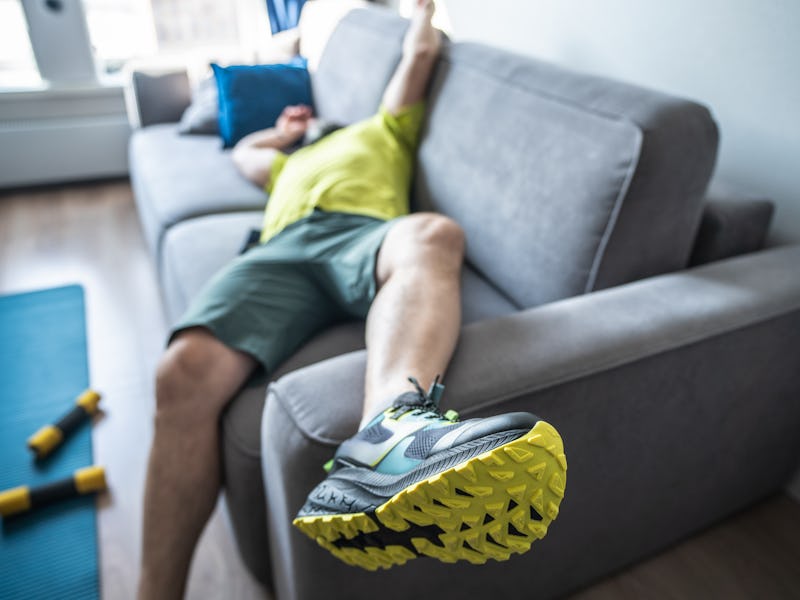The First Few Weeks of Exercise Are Often Excruciatingly Painful — Here’s What’s Actually Causing It
The challenge behind the first three weeks comes down to your body learning that it needs to be up for the task.

A cruel trick of exercise is that in order for it to make us feel good, we have to feel bad first. For all the endorphins and endocannabinoids that get released when we break a sweat, it feels like we must break our spirit to reap those rewards. The good and bad news is that getting started is the hardest part.
Anyone who’s tried to jump on a workout routine knows that the first three or so weeks can be the hardest for many reasons. It’s an adjustment to our schedule, it’s psychologically challenging, and it’s not always the most fun. But there’s a physiological reason too, and understanding the science behind it might make getting over that initial hump a little easier.
The challenge behind the first three weeks comes down to your body learning that it needs to be up for the task. Whether you’re doing cardio or strength training, that task will look a little different.
When you begin resistance training, you’re creating microscopic tears in your muscles, according to Benjamin Gordon, instructional assistant professor of applied physiology and kinesiology at the University of Florida. These tears are palpable as delayed onset muscle soreness, or DOMS, the condition in which you feel extremely sore the day after working out.
This small-scale injury requires your body to synthesize protein from amino acids to repair the muscles. Protein synthesis comes from a pathway called mechanistic target of rapamycin (mTOR), which is stimulated during mechanical action like exercise.
“When we lift a weight, we can stimulate that pathway,” he says. “It's basically like a bunch of dominoes getting to mTOR at the end.”
But the muscle repair phase doesn’t last forever. Once your body has experienced the stress only a couple times, it moves from repairing muscles to building them, or muscle hypertrophy. That shift, Gordon says, comes at around the three-week point — though it’s different for everyone. This shift comes because your body learns how to deal with the stress it encounters, and prepares for the next round.
“Your body's realized, ‘Okay, we can handle the stress that we're at. Now, how can we better handle it? What can we do to make ourselves more prepared the next time we experience stress?’” he says. Once your body makes that switch from muscle repair to muscle building, exercise gets easier.
“Your body's realized, ‘Okay, we can handle the stress that we're at. Now, how can we better handle it? What can we do to make ourselves more prepared the next time we experience stress?’”
With cardio, your body must adjust to the maximum volume of oxygen consumption, or VO2 max. VO2 max refers to the amount of oxygen your heart can deliver to your muscles with every pump of blood. “As you're training, the heart becomes more efficient at pumping out blood,” says N’Namdi Nelson, an exercise physiologist at the NYU Langone Health Sports Performance Center. Also a muscle, your heart gets stronger and better able to pump blood throughout the body. “If you can get more blood out with every beat, then that's more oxygen delivered” to your muscles, he says.
Gordon adds that your heart physically stretches out to accommodate more plasma, which creates a stronger contraction. “You end up pumping much more blood with that additional plasma volume,” he says.
Nelson notes that you might notice changes in just a couple of weeks, depending on your exercise regimen. It could even show up in small ways, like how winded you get walking up stairs. “Now you're like, ‘Oh, wow, before I was out of breath when I got to the second flight and now I'm not out of breath anymore,’” he says.
The rate of this change also depends on exercise intensity, frequency, and duration. According to the American College of Sports Medicine guidelines, you need to do at least 20 minutes of moderate cardio about 5 days a week to see improvements in your blood pumping efficiency. For resistance training, you need to exercise every muscle group with at least 2 to 4 sets of 8 to 12 repetitions at least twice a week. But remember that a little exercise is still better than none, and slow progress is better than no progress.
“We are supposed to enjoy the results of exercise...exercise is never going to feel, you know, awesome.”
Both Nelson and Gordon describe the psychological challenge that comes with starting a workout, too. Nelson says that without proper preparation or guidance, going to the gym can be intimidating for newcomers. Gordon also says that people might get frustrated early on because of how difficult exercise feels, even if it feels good after the fact. While exercise can be an invigorating challenge, it’s not fun in the way that, say, going to the movies is fun. We must recognize and accept exercise for what it is: stress. Stress isn’t usually enjoyable.
“We are supposed to enjoy the results of exercise,” he says, but “exercise is never going to feel, you know, awesome.”
Which isn’t to say exercise must be a tribulation in order to be beneficial. No matter where you’re starting, as long as you’re consistent, your body will adapt after just a few weeks.